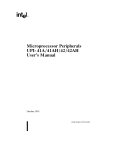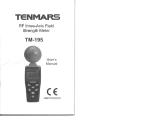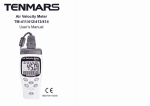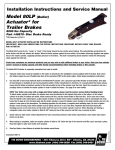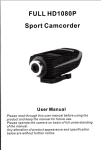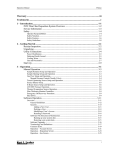Download Electronic maze game
Transcript
United States Patent [191 [11] 4,323,242 Rosenfeld [45] Apr. 6, 1982 [54] ELECTRONIC MAZE GAME [76] Inventor: FOREIGN PATENT DOCUMENTS Peter E. Rosenfeld, 149 Mountain Ave., Berkeley Heights, NJ. 07922 [21] Appl. No.: 189,583 2040695 9/1980 United Kingdom .......... .. 273/1 GE Primary Examiner-Vance Y. Hum [57] ABSTRACT An electronic maze game comprising a maze which is [22] Filed: Sep.23, 1980 [51] Int. Cl.3 .............................................. .. A63F 9/06 [52] U.S c1 .................... .. 273/153 R; 273/1 GC [58] Field of Search .............. .. 273/1 GC, 1 GE, 1 E, 273/153 R, 138 A, 237, DIG. 28; 434/201; 364/410, 411 [56] References Cited U.S. PATENT DOCUMENTS 4,051,605 10/1977 Toal et a1. ......................... ,. 434/201 4,103,895 8/1978 4,126,851 11/1978 Pressman et a1. . .. Okor ......................... .. 273/237 4,240,638 12/1980 Morrison et al 4,249,734 4,275,443 2/1981 6/1981 273/153 R Bromley ...................... .. 273/94 Sorin ................................. .. 273/237 stored electronically in the memory of a microcom puter, a four bar display which indicates if there is a wall or an opening immediately above, below, right or left of the player’s present position, and four push but tons which permit the player to make a move from his present position to the adjacent position lying above, below, to the right or left, provided that such move is not blocked by a wall. A number of different mazes are stored in the game, and the player may choose to play a “beginner”, “intermediate” or “advanced” game, or repeat the last game played. A two digit display tells the player at the beginning of the game the minimum num ber of moves required to transit the maze, and during play of the ‘game, the number of moves the player has made. 8 Claims, 4 Drawing Figures US. Patent Apr. 6, 1982 Sheet 1 of3 FIG. 3 ROWS 23 COLUMNS 4,323,242 US. Patent FIG Apr. 6, 1982 Sheet 3 of3 4 - 4,323,242 ' START EE'BEJK CLEAR MOVES ONTR wAn FOR |00 Ms A MOVES REG " A 40o /40[ , RNTN N0 BUTTONS 1 _ —- ENABLE El. PUSHED GLEAR FOUR BAR - ‘ DISPL_AMY__K,__ WAIT FOR A _ BUTTON PUSH 402 ‘ sET sELEcT MAZE FLAG :“4'4 403 GENERATE YES SEL IP?AZE 40s N0 \) IONNTEHéJLPET TNGREMENT 3 4'5 AARERL TRANSFER 404 A RESULTS To 405 MovEs REG GLEAR sELEGT MAzE FLAG 1 ENTER UPON '"TERRUPT 42' cALGuLATE NEN . GAME NuMBER - ’\ 4'6 N0 , 4n \ 401 MALT PLAY G 3 BLANK FOUR BAR DLSPLAY TRANSMH' NEW GAME NuMBER WA" FOR & oEvNEDR IONATBEL§RUK|LDT RECEIVE NEN GAME GET START 8‘ END GET mm L END CELL LOGS & MIN No. MovEs FROM TABLE LNITIALIZE DISPLAYS FOR NEN GAME l RETuRN FROM \NTERRUPT - MAKE MOVE 409/‘ A DISPLAY '\-41@ NEW‘CELL RN BANNER ' FROM TABLE ‘ 1 N0 No PUT MLN N0.0F YES M°V%SEGT'§'TEM;?VES “/ 4'9 4N-/~ l DISPLAY FIRST CELL OF ME _ p420 END0'5"” sYNBoL A GENERATE 4|g-/~ INTERRUPT 0N GABLE Ala E WAIT FOR sELEcT MAzE BuTToN TO BE PUSHED 4,323,242 1 2 FIG. 4 is a ?owchart of a computer program which ELECI‘RONIC‘MAZVE GAME may be stored in and executed by the electronic cir cuitry of FIG. 2 in the practice of my invention. SUMMARY OF vTHE‘INVENTION This relates to a game in which one or more players try to work their way out of a maze in a minimum BEST MODE OF CARRYING OUT THE INVENTION FIG. 1 depicts an electronic maze game 100 of my length of time, or in a minimum number of moves, using invention as it would be packaged in a hand held case. a display which shows them only the structure of the ‘Shown in the middle is a four bar display 107 compris maze in their immediate vicinity. 10 ing a bottom bar 108, a left bar 109, a top bar 110 and a In a prefered embodiment of the invention, a four bar right bar 111. To the left of the four bar display is an display, arranged in the shape of a square, indicates if On/Off switch 101. To the right of the four bar display there is a wall or an opening immediately above, below, is a Select Maze push button 102. Below the four bar right and left of the player’s present position. Four push display are four move push buttons, a Move Down buttons are used by the player to make a move from his present position to the adjacent position lying above, button 103, a Move Left button 104, a Move Up button 105, and a Move Right button 106. These same four buttons are used immediately after the Select Maze button 102 has been pressed to select a beginner, inter below, to the right or left, provided that such move ment is not blocked by a wall. A two digit display tells the player at the beginning of the game the minimum mediate, or advanced level game or a repeat of the last number of moves required to transit the maze, and dur 2,0 game played, respectively. Shown above the four bar ing play of the game, the number of moves the player display is a two digit Seven Segment display 112 which had made. is used immediately after a game has been selected to A number of different mazes are stored in the game, display the minimum number of moves to solve the and the player may choose to play a “beginner”, “inter particular maze, and is used after the ?rst move has been mediate”, or “advanced” game, or repeat the last game 25 made to display the number of moves the player has played. In its present embodiment, the game contains made. In thevupper right hand corner is a jack 113 used four beginning, four intermediate and eight advanced to connect to similar other maze games (not shown) mazes, and a random number generator is used to select over a two conductor cable (not shown). At the top of the particular maze from within the category the player the case is shown a picture 114 of one of the 16 mazes has chosen. stored in the memory of the game, in particular, one that can be selected by pressing the Select Maze and ‘ When the game is played by a single player, the ob ject is to complete it in the minimum number of moves, Move Right (Repeat Game) buttons immediately after which means that the player will normally repeat a turning on the On/Off switch. This maze is pictured on particular maze a number of times, trying to improve his 35 the case as an aid to a ?rst time user of the game, to help performance by avoiding dead ends or circituitous him understand its operation. paths encountered on previous tries. For play by more than one person, provision is made for connecting two or more units together using a signaling cable, which how to implement the game with a particular set of FIG. 2 is an electrical schematic diagram showing‘ electronic components, in particular an Intel Corpora tion 8748 microcomputer integrated circuit 200 and a Hewlett. Packard Corporation two digit seven segment play on all units when any player completes the game. display. The reader who is not familiar with the opera At the moment that the game is won, the winner’s dis tion of the Intel Corporation 8748 microcomputer is play shows all four bars, and the losers’ displays show refered to the Intel Corporation publication “MCS-48 no bars. The winner is now allowed to select the next game to be played, and as soon as it is transmitted over 45 MICROCOMPUTER USER’S MANUAL”, copy right 1978. For convenience, elements common to the cable to the other units, play resumes. The ability to causes all units to display the same maze, and to halt connect a number of units together over a cable is con sidered an important feature of this game, as it allows a number of players to make moves simultaneously rather than in sequence as is usual in games for multiple play ers. This may make the game more exciting to children FIGS. 1 and 2 are identi?ed by the same numbers. It is to be understood that this game could be implemented with microcomputers and displays manufactured by others, but a different wiring diagram would result. In a preferred embodiment of my invention each maze is a two-dimensional square maze, and 16 such mazes are stored in a table in the memory of the micro game to be played by people in different rooms, which processor. Four of these mazes are beginner level 4X4 may also have appeal to children. _ i ' ‘ 55 mazes, four are intermediate level 6 X 6 mazes, and eight are advanced level 8X8 mazes. An illustrative such BRIEF DESCRIPTION OF THE DRAWINGS 8 X 8 maze 'is shown in FIG. 3. These and other objects, features, elements and ad To store the maze, and determine movement through vantages of my invention will be more readily apparent the maze, each maze is regarded as composed of m by 11 who get impatient waiting for a mm. It also allows the from the following detailed description of the invention in" which: FIG. 1 is a depection of an illustrative em bodiment of my‘ invention, packaged in a hand-held case; FIG. 2 is a schematic diagram of electronic circuitry cells and each cell is represented by a number having the from a,b where a represents the column in which the cell is located and b represents the row. For conve nience, the rows and columns of the 8 X 8 maze of FIG. 3 are numbered, and the corner cells are designated 0,0 suitable for implementing the illustrative embodiment 65 0,7 7,7 and 7,0 proceeding clockwise from the lower of FIG. 1; ' ‘ ~ FIG. 3 is an illustrative example’of a maze which ma be played with the embodiment of FIG. 1;‘and lefthand corner. The designation of the other cells will be apparent. A player’s position in the maze can there fore be represented by the number a,b of the cell where 3 4,323,242 4 binary notation for each dimension of each cell whether 402 where the program loops until it detects the opera tion of one of the aforementioned push buttons 102-106. Below this is a Disable Program Interrupt (P.I.) block 403 where the program disables the External Interrupt there is or is not a wall in the direction of forward or circuitry used to detect signals arriving via jack 113 the player is; and this number can be stored by one or more registers of microprocessor 200. The maze itself is stored in a table which indicates in backward movement from that cell in that particular from another unit. It is convenient to postpone recog dimension. This table can be stored in a number of ways. To minimize storage requirements, I store only nizing these signals during the few milliseconds neces sary to respond to a local button being pressed. Next, one representation of each wall in the maze; and to follows a Test block 404 where the program branches facilitate processing, I store together the binary repre left if the “Select Maze” button 102 was pressed, and right if one of the four “Move” buttons 103-106 was pressed. In the latter event, a second test 405 is made to determine if a normal move is called for, or if the Move FIG. 3 are represented electronically in the memory of buttons are presently being used to select a new game. the microprocessor 200 by the binary number 100111101; and the walls in row 1 of the maze of FIG. 15 This test is done upon a flag set in a portion of code yet 3 are represented electronically by the binary number to be described. If a normal move is called for, the 111110111. As will be apparent, nine binary digits are program proceeds to a block 406 which represents the code necessary to increment a register used to keep needed to represent the nine walls in a row or column of track‘of the number of moves made during the present an 8X8 maze, but since the maze is assumed to have a game, and transfer the results to the register used to continuous outer wall, there is no need to represent the drive the two digit seven segment display. Next comes ?rst or last of these walls in memory. a test block 407 wherein the validity of the requested During play, the con?guration (i.e. the presence and move is determined. The state of the four bar display is absence of walls) of the cell in which the player is then examined to determine whether or not a wall segment is located is constantly displayed by four bar display 107 with lighted bars 111, 109 representing the presence of 25 indicated that would block the designated move. walls in the forward and backward directions of one Should the move be invalid, the program returns via an Enable P.I. block 408 to the Wait block 401. In the case dimension, and lighted bars 110, 108 representing the presence of walls in the forward and backward direc of a valid move, the program proceeds to a Move and sentations of all the walls in a particular row or column of the maze. Thus, the walls in column 1 of the maze of tions of the second dimension. Advantageously this display is controlled by a register into which the micro processor has loaded the binary information from the maze table which indicates the presence or absence of a Display block 409 wherein the data describing the next cell in the maze is retrieved from a table of maze data and used to update the four bar display. Next, a test 410 is made to determine if the maze cell just entered is the end of the maze. If the test 410 indicates it is not the last wall in the forward and backward directions in each dimension at the cell where the player is then located. cell, the program returns via the Enable P.I. block 408 Thus, if the player is located in cell 2,3 of the maze of 35 to the Test block 401. However, if the test 410 deter mines the cell just entered is the last in the game, the FIG. 3, the processor reads from memory the binary program proceeds to a display block 411 which causes number 10000110, representative of the walls of row 3, and shifts this number two digits to the left to read the all four bars of the four bar display to be illuminated, thus signaling the end of the game. Next follows a gen binary number 0,0 from the two most signi?cant bits, indicating there are no walls on the left and right hand 40 erate interrupt block 412 where the program causes a signal to be sent via jack 113 to other units 100, inform sides (the backward and forward direction in one di ing them that they have lost the game. There follows a mension) of cell 2,3. In like fashion, the processor also wait block 413 where the program loops waiting to reads from memory the binary number 10011111 repre detect the pressing of the Select Maze push button. sentative of the walls of column 2, and shifts this num ber three digits to the left to read the binary number 1,1 45 Next comes a Set Flag block 414 in which the ?ag tested in the test block 405 is set. This block 414 may indicating there are walls at the top and bottom (the also be entered from a Generate Interrupt block 415 forward and backward directions in the second dimen which places the signal that halts play on the cable used sion) of cell 2,3. This information is provided to the register which controls the display. ~ to interconnect two or more game units. Returning now to the Select Maze Flag test 305 we Movement through the maze is a matter of moving to the adjacent cell by incrementing or decrementing ei will examine the path taken if the ?ag is set, thereby ther the value of a or the value of b of the number a,b indicating that a new game is in the process of being selected. First comes a Clear Flag block 416 which clears the flag just tested in test block 405. Next comes representing the cell where the player is. These steps are controlled by buttons 103-106. However, before a change in cell position can be made, the validity of the 55 a Calculate New Game Number block 417 where a number obtained from a random number generator move must also be tested by checking for the absence of routine is used in conjunction with information about a wall in the direction of the move. Advantageously, ‘which of the four move buttons 103-106 was pressed, to the data that controls the display is used to test the validity of the move. FIG. 4 is a ?ow chart of the pro select a new beginner, intermediate or advanced game gram stored in and executed by the microcomputer 200 60 number, or repeat the last game number. This is fol in FIG. 2. At the top is shown an initialize block 400 lowed by a Transmit block 418 where the previously which represents the code used to initialize the various selected game number is transmitted in a pulse code registers, ?ags, and Input/Output (I/O) ports used later format over the cable used to interconnect two or more in the program. Below this is a Wait block 401. where game units. This block also contains the code to end the the program loops until it detects a continuous period of 65 program interrupt initiated either in block 412 or 415, 100 milliseconds during which none of the ?ve push and the code to get from the maze table the information button switched 102-106 are operated, and thus serves to “debounce” the switches. Below this is a Wait block about the start, end, minimum number of moves to transit the game just selected in block 417. Next comes 5 ‘6 a block 419 in which the information about the mini interconnecting cable. This block also contains code to initiallize the four bar display 107 and the seven segment display 112 for the beginning of the new game. The purposes of the other blocks in FIG. 4 will be apparent mum number of moves to transit the maze is sent to the seven segment display 112, and a display block 420 where the data de?ning the walls of the starting cell is sent to the four bar display 107. Also shown in FIG. 4 is an Interrupt Service block to one skilled in the art of computer programming. As will be apparent to those skilled in the art, numer ous variations may be made in the above described 421 which is entered if an interrupt is received over the interconnecting cable. This code halts play and blanks game and method of play that are within the spirit and scope of the invention. While the game described above the four bar display 107 to indicate that a player at another game unit has completed the maze and there fore won the game. Additional code then waits for and receives the game number for the next game to be played, when it is transmitted in pulse code over the is a two dimensionalmaze game, expansion of the game to mazes of three and more dimensions will be apparent to those skilled in the art. *MICROMAZE - Version 4 - Added code for moves counter & cable interrupts ‘Data in page 3, 16 bytes per maze, 16 mazes. ‘First 8 bytes are horiz bar info, MSB is bottom bar, ‘first byte is for X = 0 column. ‘Next 8 bytes are vert bar info, MSB is left bar, ‘first byte is for Y = 0 row. 7 ' ' ‘Start and Stop locations in top of page 2, 2 bytes/game. ‘Even addr. has Start 100., MS nibble = X, LS = Y ‘Min. # moves/game in BCD in page 2 starting at ZdO ‘r7 = XYend for present game , "r6 = pointer to data base addr for present game ‘r2 = complement of bus, i.,e.state of 4 bar display “r0 & r1 are scratch pads used in button debounce. *RBl assignments - r7&4 save AC r5&6 number of moves ‘P2 drives 7 seg. disp. - bits 6 to 0 = segments a to g ‘P2 bit 7 connects to INTerupt for cable driver ‘Pl bits 7 & 6 drive cathode 2 and 4&5 cath. 3 (Cl doesnt exist) ‘Pl bits 0,l,2,3 read switches rt 1f dn up ‘TO reads reset sw ‘Bus drives 4 bar disp. bits 0&4 top 1&5 bot, 2&6 it, 3&7 1ft *To get vert bars, add 8 to Y value plus maze base addr ‘to get addr of bye to be shifted left X times. Bits *7 and 6 then de?ne state of vert bars. ‘To get horiz bars, add X value ot maze base addr to form ‘address of data byte which is then shifted left Y times. ‘Then use bits 7 and 7 (7 is bot bar). org clr a jmp init org 3 jmp intr ‘Display BCD # in RBI r6, different digit each time clk ticks org msd callx clkret sel rbl mov r7,a save ac in jb7 a,pl msd Which digit is displayed now? mov a,r6 display LSD call mov xlate a,#0cfh Select cathode 3 outl jmp pl,a clkret mov a,r6 swap a anl a,#0fh jnz callx mov a,#0ah call xlate mov a,#3fh outl pl,a mov a,#0c0h mov mov retr t,a a,r7 Test for leading zero 10 = blank , . Select cathode? Restore ac "Xlate subroutine - BCD to 7 seg. xlate anl a,#0fh add a,#xbase in a,p2 anl a,#80h outl p2,a ret Mask off left digit Combine 7 seg data with P1 bit ' v " 4,323,242 7 ‘continued xbase db db db db db db db db db db db 7eh 30h 6dh 79h 33h Sbh lt‘h 70h 7m 73h 0h ‘interrupt routine - used when cable connects several units ‘Signals end of game (you loose) and next game number intr iwait ihere sel rbl mov sel r7,a rbO clr a cpl a outl bus,a mov r3,a Save AC blank the box display mov a,#8eh outl p2,a in cpl a,p2 a Wait for new game number jb7 iwait Jump if interrupt still at gnd inc r3 Incr. new game no. cntr. mov djnz rl,#60h rl,ihere Wait to see if inter. has ended in a,p2 cpl a ib7 iwait call xyss call displa sel rbl mov a,r7 Set 7 seg. display to L Jump if inter. still in progress ‘ Restore AC retr ‘Program starts here init sel rbl mov r6,a sel outl cpl rbO bus,a a Initialize display to check battery mov r2,a set r2 to “box" mov (AC is already 0) r3,#4 Select opening game strt t Start random number generator start en en tcnti i start2 wait mov djnz r0,#20h rl,wait jntO in start2 a,pl nobut cpl a anl jnz a,#0fh start2 djnz r0,wait jntO reset in a,pl Test for button pressed cpl a an] jz a,#0fh nobut dis j?) i newgam sel rbl Increment # moves counter mov mov r4,a a,r5 save AC add a,#1 da a mov mov mov r5,a r6,a a,r4 rbO sel up wait for 200 ms of no buttons jb3 up jb2 dn jbl lt jbO rt jmp mov jbO inc start a,r2 start r4 Jmp out Test for game selection restore AC continuing game, get dir. of move . hardware error if you get here valid move? jmp if no yes 10 -continued dn It rt out me reset newgam beg int adv setss xloop . mov a.r2 jbl start dec jmp mov jb3 dec r4 out jmp out a,r2 start r5 mov a,r2 jb2 start inc r5 call displa mov a,r5 swap a Test for end add xrl a,r4 a,r7 jnz strt Keep going clr a End outl bus,a Display box cpl mov a r2,a anl p2,#7fh Generate interrupt jtO dis me i Wait for reset button anl p2,#7fh Generate interupt clr ?) cpl ?) Set ?ag clr sel mov mov sel mov cpl a rbl r5,a r6,a rbO r2,a a Clear Display outl jmp bus,a start2 clr jbO 10 setss jbl int jb2 beg clr moves cntr and register Clear reset ?ag repeat last game jb3 adv jmp start error if pgm gets here mov a,t Get random number anl a,#3 Mask'it mov r3,a jmp setss mov a,t anl orl a,#3 a,#4 mov r3,a jmp setss mov a,t anl orl a,#7 a,#8 mov mov ids mov inc r3,a a,r3 tcnti orl p2,#80h djnz r0,kt Add offset Xmit game # r0,a r0 en tcnti call xyss call displa jmp start clear interrupt kt mov rl,#40h time delay for game # xmit routine kt2 djnz anl rl,kt2 p2,#7fh Set interrupt mov rl,#40h kt3 djnz rl,kt3 jmp xloop ‘Display subroutine displa mov a,r5 VERT BARS - set up cntr Get Y add 8 add data table base addr get data word set carry cpl c 11 4,323,242 -continued rrc rlc rotate X times djnz an] horiz mov Get 2 bits Save them mov HORIZ BARS - set up cntr mov inc Get X add data table base addr mov add movp3 clr hrot cpl C rrc a rlc djnz anl rr rr add mov swap add mov cpl out] disret ret ‘XYSS subroutine - org xyss gets Xystart, xyend, & min. # of moves from page 2 200h mov a,r3 1'] inc add a form xyend movp get byte mov Save it mov fonn start 100. rl add movp mov swap an] mov mov anl mov mov Get min # of moves add movp sel mov mov sel mov swap mov ret end 2d0: 9 9 813 21131618 28 32 32 20 37 35 25 3O 032032310300 0520451505045 30271274075327 760175277227 98d898a80000 98e8a8880000 9098d8‘a80000 a8e8c8880000 8828a8c80000 e8a8d8a80000 c8b8a8c80000 28a898a80000 l2bafel‘2ead200 c282868ad6ca00 92fece8edcaa00 969aaa92828600 Multiply game # by 16 12 13 4,323,242 14 -continued What is claimed is: 1. An electronic maze game comprising: 4. The electronic maze game of claim 3 wherein the display elements are liquid crystals or light emitting means for storing an electronic representation of a diodes. 20 maze of at least two dimensions; 5. The electronic maze game of claim 1 further com means for storing an electronic representation of a prising means for displaying during play of the game the player’s present position in said maze; ., number of steps a player has taken through the maze. means coupled to said means for storing an electronic 6. The electronic maze game of claim 1 wherein in representation of a maze for displaying for said each array of pairs of display elements one of said dis present position the presence or absence of a wall 25 play elements indicates the presence or absence of a in the forward direction and the backward direc wall in the backward direction in one dimension and the tion for-each dimension of the maze said displaying other indicates the presence or absence of absence of a means including an array of pairs of display ele ments, one pair for each dimension of the maze; means for moving from said present position to an wall in the forward direction in such dimension. 7. The electronic maze game of any one of claims 1, 3 or 6 wherein the means for moving comprises one pair of switches for each dimension of the maze, one of said switches signifying a move in the backward direction in such dimension and the other signifying a move in the adjacent position in said maze; and means for testing for the validity of a move by testing for the presence of a wall in the direction of the forward direction, said switches being selectively actu move. 2. The electronic maze game of claim 1 further com 35 prising: atable by the player. 8. A method of operating an electronic maze game comprising the steps of: means for connecting said maze game to a second said maze game; storing an electronic representation of a maze of at means for playing the same maze simultaneously on both said maze games; and least two dimentions; storing an electronic representation of a player’s pres ent position in said maze; means for indicating when a player has completed one of said mazes before the other is completed. 3. The electronic maze game of claim 1 wherein the maze is a two-dimensional rectangular maze and the displaying for said present position the presence or absence of a wall in the forward direction and the displaying means is a rectangular array of display ele 45 ments, the left and right display elements indicating the presence and absence of walls in the backward and forward directions in one dimension of said maze, and backward direction by an array of pairs of display elements, one pair for each dimension of the maze; signifying an intended move from said present posi tion to an adjacent position in said maze; and testing for the validity of said intended move by test ing for the presence of a wall in the direction of the the top and bottom display elements indicating the pres ence and absence of walls in the forward and backward 50 directions of the second dimension. 55 60 65 mOVe. * * =0! * 1k











